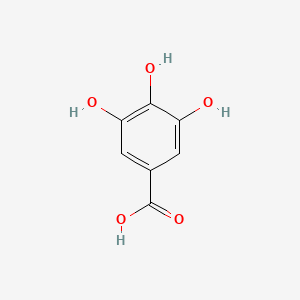| Immunomodulatory mechanism :
|
Inhibitory activity of gallic acid against bacterial dihydrofolate reductase and its excitatory activity on topoisomerase IV-mediated DNA cleavage in different bacteria; penetrate the bacterial cell membrane and interfere with the electron transport chain and cellular respiration; inhibit HIV-1 integrase, HIV-1 transcriptase, HIV-1 protease dimerization, HCV attachment and penetration, HCV replication, HCV serine protease, herpes simplex virus (HSV)-1 and HSV-2 attachment and penetration. Disruption in Haemophilus influenza A and B particles. Can bind to the glutamate-gated chloride channels in the nervous system of Caenorhabditis elegans and initiates the hyperpolarization of the cell membranes and excitation of muscles. Gallic acid can exert its cytotoxic and antitumor effect via modulation of antioxidant/pro-oxidant balance. In some cases, the compound can control the reactive oxygen species (ROS)-induced carcinogenesis through increasing the activity of superoxide dismutase (SOD), catalase (CAT), glutathione reductase (GR), and glutathione peroxidase (gpx) and/or by reducing the lipid peroxidation and ROS production. In other cases, gallic acid can induce the cell cycle arrest, autophagy, and apoptosis via activating the caspases pathway and ROS generation. In addition, it can inhibit the invasion and metastasis by decreasing the matrix metalloproteinase expression and activity. Reduction of the expression of pro-inflammatory mediators (i.e., tumor necrosis factor (TNF)-α and inducible nitric oxide synthase (i-NOS)), up-regulation of the pro-angiogenesis factors (i.e., Von Willebrand factor (vwf) VIII, mucosal hepatocyte growth factor (HGF) and vascular endothelial growth factor (VEGF)), promotion of angiogenesis, and inhibition of the expression of apoptosis parameters (i.e., caspase-3 and caspase-9). Increases the cellular glucose uptake via stimulation of the phosphatidylinositol 3-kinase (PI3K)/p-Akt signaling pathway and translocation of insulin-stimulated glucose transporters, such as GLUT4, GLUT2, and GLUT1. Increases the rate of apoptosis via stimulation of the c-Jun N-terminal kinase (JNK) protein, down-regulation of Bcl-2 protein, inducing poly (ADP-ribose) polymerase cleavage, or even increasing intracellular Ca2+ and ROS generation; decreases the expression and release of pro-inflammatory and inflammatory mediators, such as bradykinin, substance P, COX-2, NF-κb, IL-2, IL-4, IL-5, IFN-γ, and TNF-α. The compound also inhibits the phagocyte- or polymorphonuclear (PMN)-mediated inflammatory responses by scavenging ROS and decreasing the myeloperoxidase (MPO) activity.
|
